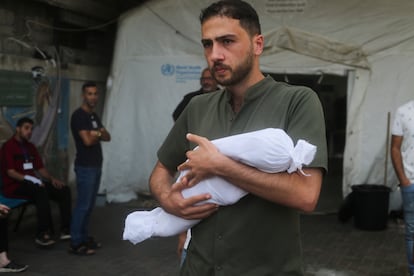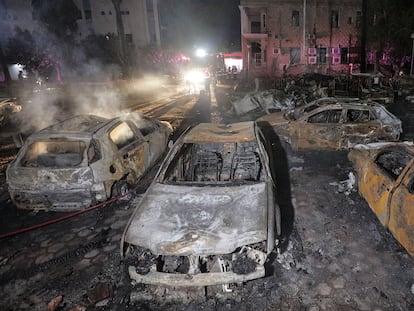Gaza authorities: Israeli army has killed more children in two weeks than in the last 23 years
Over 2,300 minors in the Strip have died under the Israeli bombardment, while those who remain in the war zone are exposed to hunger, thirst and serious damage to their mental health

On September 30, 2000, 11-year-old Muhammad al-Durrah was caught in the crossfire between militias and Israeli soldiers in Gaza and died instantly. His death was the first in a chillingly long list that the Israeli Information Center for Human Rights in the Occupied Territories, B’Tselem, began compiling that year to keep track of the casualties in the Israeli-Palestinian conflict. Twenty-three years later, as of October 6, 2023, at least 1,741 further minors had lost their lives as a result of violence in Gaza. After two decades, Palestinian children are being punished more than ever: in the three weeks since the Islamist militia Hamas attacked Israel on October 7 — leading to an Israeli bombardment of the Strip in retaliation — a bloody record has been reached: at least 2,360 children have died under Israeli bombs, according to data provided Tuesday by the Gazan Health Ministry. In just 18 days, the total number of children killed in the last 23 years has been surpassed.
At least 2.2 million people, half of whom are minors, are trapped in the Gaza Strip, which some analysts have described as the largest open-air prison in the world: a territory of 365 square kilometers (141 square miles), about the same size as Las Vegas, which cannot be entered or exited by land, sea, or air after Israel imposed a total siege following the attack of October 7. There is hardly any drinking water left in the enclave and electricity, food and medicine are scarce. Trucks carrying humanitarian aid are only allowed to pass through in dribs and drabs. There is, however, no shortage of missiles: up to 6,000 were fired by the Israeli army in the first six days of the siege, killing 1,140 people.
Shortages, fear, insecurity and death have become permanent companions for girls like 16-year-old Dima Allamdani, who last week buried 13 members of her family. “I came to look for my father, mother and siblings at the morgue. First they told me: come and look at your mother. They didn’t show me her face, but I recognized her by her feet,” the teenager, her face bruised and dirty, told Reuters reporters. “It broke my heart; it’s a nightmare.” She speaks sitting on a rug, with another boy, about 10 years old, beside her, whose legs are half-bandaged, covered in wounds and with a black eye.
Allamdani’s family was one of many who moved to the south of the Strip to avoid Israeli air strikes. They settled in a temporary shelter in the town of Khan Younis, but an attack on the night of October 17 hit the area. Allamdani, one of her brothers and two younger cousins were the only survivors.

In addition to those killed, at least 5,000 children have been reported injured and 800 more are missing, probably buried under the rubble of destroyed buildings, according to Palestinian officials. “Thousands of homes and dozens of playgrounds, schools, hospitals, churches and mosques have been damaged or destroyed in Gaza,” the Gazan Health Ministry reports. Of the injured children, the same source claims that some are enduring “excruciating burns, loss of limbs, and other horrific injuries caused by the shelling.”
This is not a new situation. Gaza has been the scene of military incursions and attacks since it passed from Israeli to Palestinian hands in 1994, when the Oslo Accords were signed. All of Gaza’s residents have been affected by violence, to a greater or lesser degree. Like an old man recalling the vicissitudes of his past, teenagers now turning 17 can claim to have already survived five armed conflicts. Their lives began in 2006, just before the first Israeli blockade of the Strip in 2007, with the rise of Hamas to power. In that time, they have been through the 2008-2009 war, which lasted 23 days; the 2012 war, which lasted eight days; the 2014 war, which lasted 50 days and was the bloodiest to date at that time; the 2021 war, which lasted 11 days; and the current war, which began on October 7.
Haneen Harara is a 29-year-old Gazan journalist, mother of three and a regular collaborator with the U.N. Relief and Works Agency for Palestine Refugees in the Near East (UNRWA). Two weeks ago, she described her evacuation during an EL PAÍS podcast. On October 18, she sent a couple of videos with the little electricity she had. “There has been no electricity for two days, there is no food...,” she said, while recording a darkened room in which children’s voices can be heard. “The children are here looking for something to eat, we use the cellphones to provide some light before the battery runs out,” she continues. With the phone’s flashlight, Harara shines a light on what looks like a tomato and three pieces of pita bread. A pair of hands shreds it. “There is some bread here, but unfortunately there is no water,” she adds.
The lack of water and food affects children most seriously, especially those in their first 1,000 days of life, the most important stage of development. Even before this offensive, 60% of the Gazan population required humanitarian aid to survive and the U.N. World Food Program recorded 1.84 million people as food insecure — i.e. without access to sufficient food for their health and general well-being. In addition, 7.4% of children aged six to 59 months suffered from some form of malnutrition. According to UNICEF, less than half of the child population receives a minimally diverse diet and about 10% of children under five years of age are stunted.
With desalination plants unavailable due to lack of fuel, and empty supermarkets, many Gazans are forced to drink from any source available, even from the sea. “The population is consuming saline water with more than 3,000 milligrams per liter of salt content from agricultural wells. This poses an immediate health risk by raising hypertension levels, especially in babies under six months old, pregnant women and people with kidney disease,” warns the latest situation report from the United Nations Office for the Coordination of Humanitarian Affairs (OCHA). The use of saline groundwater also increases the risk of diarrhea and cholera. The first cases of chicken pox, scabies and diarrhea, attributable to poor sanitation and consumption of water from unsafe sources, have already been detected. “The incidence of these diseases is expected to increase unless water and sanitation facilities are provided with electricity or fuel to resume functioning,” the OCHA stated.
Long-term effects
The numerous armed conflicts around the world have led to detailed documentation of the effects of violence on children. One of the most recent, focusing on Gazan minors, was published by Save the Children in 2022 and claims that four out of five suffer from depression, pain and fear. When asked about their daily lives in Gaza, children and adolescents reported “living in a perpetual state of fear, worry, sadness and grief, waiting for the next round of violence to erupt, and feeling unable to sleep or concentrate,” according to the report. Sustained violence for more than 15 years has meant that eight out of 10 children report feeling emotional distress and grief, as well as having difficulty with homework and socializing. “We face the most terrible days imaginable. Many feelings and thoughts that you can’t even describe: fear, horror, anxiety...,” Lina, 16, said in a message posted last week on social networks.
“We have worked with many children who show signs of anxiety and depression from a very young age,” Jason Lee, Save the Children’s director for the Palestinian territories, told this newspaper, warning that the cases will not stop rising “until the cycle of violence in Gaza ends.” A UNRWA study conducted just nine months after the 2021 conflict showed that at least four out of 10 children were still in need of psychosocial intervention for post-traumatic stress disorder.
Long-term effects among children living in conflict zones range from denial or suppression of emotions to suicide attempts, according to the Save the Children report. OCHA recorded that between 2020 and 2021, there were 44 cases of attempted suicide in Gaza, compared to eight recorded in 2019. “For children to begin to feel safe, they need to believe there is a future,” Lee states, although he acknowledges that as long as the war with Israel remains active, and in the face of an expected ground incursion, it is “very difficult” to protect Gazan children.
The murder of Muhammad al-Durrah, the boy who inaugurated the list of child victims in Gaza, went viral at a time when there were no social networks, because it was recorded live by a French television station. His case went around the world; the youngster was declared a martyr and the image of him being embraced by his father as he tried to protect him from the bullets, cornered between the two sides of the gunfire that cost him his life, became a symbol of the Palestinian struggle. Of the rest of the more than 4,000 children killed in Gaza between 2000 and this Tuesday, barely a number and a name remain in the reports of the United Nations or NGOs. And the list continues to grow.
Sign up for our weekly newsletter to get more English-language news coverage from EL PAÍS USA Edition
Tu suscripción se está usando en otro dispositivo
¿Quieres añadir otro usuario a tu suscripción?
Si continúas leyendo en este dispositivo, no se podrá leer en el otro.
FlechaTu suscripción se está usando en otro dispositivo y solo puedes acceder a EL PAÍS desde un dispositivo a la vez.
Si quieres compartir tu cuenta, cambia tu suscripción a la modalidad Premium, así podrás añadir otro usuario. Cada uno accederá con su propia cuenta de email, lo que os permitirá personalizar vuestra experiencia en EL PAÍS.
¿Tienes una suscripción de empresa? Accede aquí para contratar más cuentas.
En el caso de no saber quién está usando tu cuenta, te recomendamos cambiar tu contraseña aquí.
Si decides continuar compartiendo tu cuenta, este mensaje se mostrará en tu dispositivo y en el de la otra persona que está usando tu cuenta de forma indefinida, afectando a tu experiencia de lectura. Puedes consultar aquí los términos y condiciones de la suscripción digital.
More information
Archived In
Últimas noticias
Most viewed
- Sinaloa Cartel war is taking its toll on Los Chapitos
- Oona Chaplin: ‘I told James Cameron that I was living in a treehouse and starting a permaculture project with a friend’
- Reinhard Genzel, Nobel laureate in physics: ‘One-minute videos will never give you the truth’
- Why the price of coffee has skyrocketed: from Brazilian plantations to specialty coffee houses
- Silver prices are going crazy: This is what’s fueling the rally










































